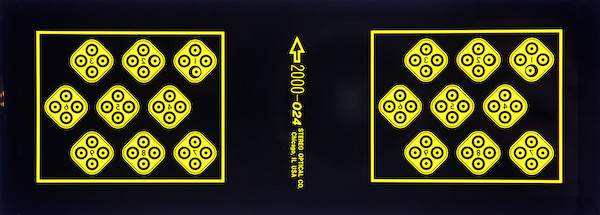Titmus V4 Vision Screener Titmus products set the standard for vision screening instruments in 1959, with the introduction of the OV7 model vision screener. As the market leader, Honeywell has now developed the new Titmus VSeries of vision screeners. We have taken the. Professional vision testing slides for Titmus models V4, and V2 are included as a package (above) with your new vision screener instrument, or are available individually as follows. Slide 18074 (Test No. 1, SA-APS-1) Allen Picture Test measures binocularity and acuity. Line 1 - Binocularity - tests performance of both eyes together. Titmus Occupational Landolt Slides. Slides for Occupational Landolt Titmus V2 and Titmus V4 vision screeners. Tests are administered at Far, Near and Intermediate distances. SF-1 Slide, Binocular Vision. SAB-1 Acuity Both Eyes. SAR-1 Acuity Right Eye. SAL-1 Acuity Left Eye. SSD-1 Stereo Depth (Depth Perception) 18071.



- The Titmus V4 Vision Screener is equiped with a head sensor which checks electronically to ensure correct head position. Patient cannot see tests, if head is incorrectly positioned. Soft headrest ensures correct head position and is easy to clean. There are a total of.
- Slides for Pediatric Model. Preschool Children. The “E” points to a Bird, a Rabbit, a Girl or a Boy. 1, SMPS-B2 —Binocularity. Tests performance of both eyes together. 2, SMPS-30-1 —Acuity. Muscle imbalance. Right and Left Eye, 20/30. The “E” points in a different direction for each eye.tested at predetermined pass/fail levels.
Honeywell Titmus Vision Screener

Titmus Vision Tester
Slide 18070 (Test No. 1, SF-1) for binocularity in both eyes is used to determine whether both eyes are being used together.
Slide 18066 (Test No. 2, SAB-1) is used to test visual acuity in both eyes. This psychologically sound pattern of Landolt Rings provides a precise measure of acuity with literates or illiterates. Easy to administer. The test symbol to be indentified is the unbroken ring.
Slide 18065 (Test No. 3, SAR-1) is used to test visual acuity in the right eye. Same as Both Eyes 18066, except Landolt Ring symbols are omitted from left eye area. Permits measuring the habitual functioning of the right eye while both eyes look at the slide.
Slide 18064 (Test No. 4, SAL-1) is used to test acuity in the left eye and is similar in principle to that used for the Right Eye 18065 described above.
Slide 18087 (Test No. 5, SSD-1) is a precise measure of one of the important factors of depth perception. The reliability of test results is high. It provides an excellent measure of binocular skill and is easily administered.
Slide 18071 (Test No. 6, SCD-1) is used to test color perception, and consists of six accurately and authentically reproduced Ishihara Pseudo-Isochromatic plates. Detects color deficiency, but does not classify.
Slide 18089 (Test No. 7, SVP-1) measures vertical balance between the two eyes. Good vertical alignment is an important factor in comfortable, efficient, two-eyed vision and is related to efficiency in most occupations.
Slide 18073 (Test No. 8, SLP-1) measures lateral phoria. Desirable phoria scores are associated with quick, accurate eye fixations and precise, effortless seeing.
Visual Acuity results calibrated at 20/13, 20/15, 20/17, 20/18, 20/20, 20,22, 20/25, 20/30, 20/35, 20/40, 20/50, 20/70, 20/100 and 20/200.
